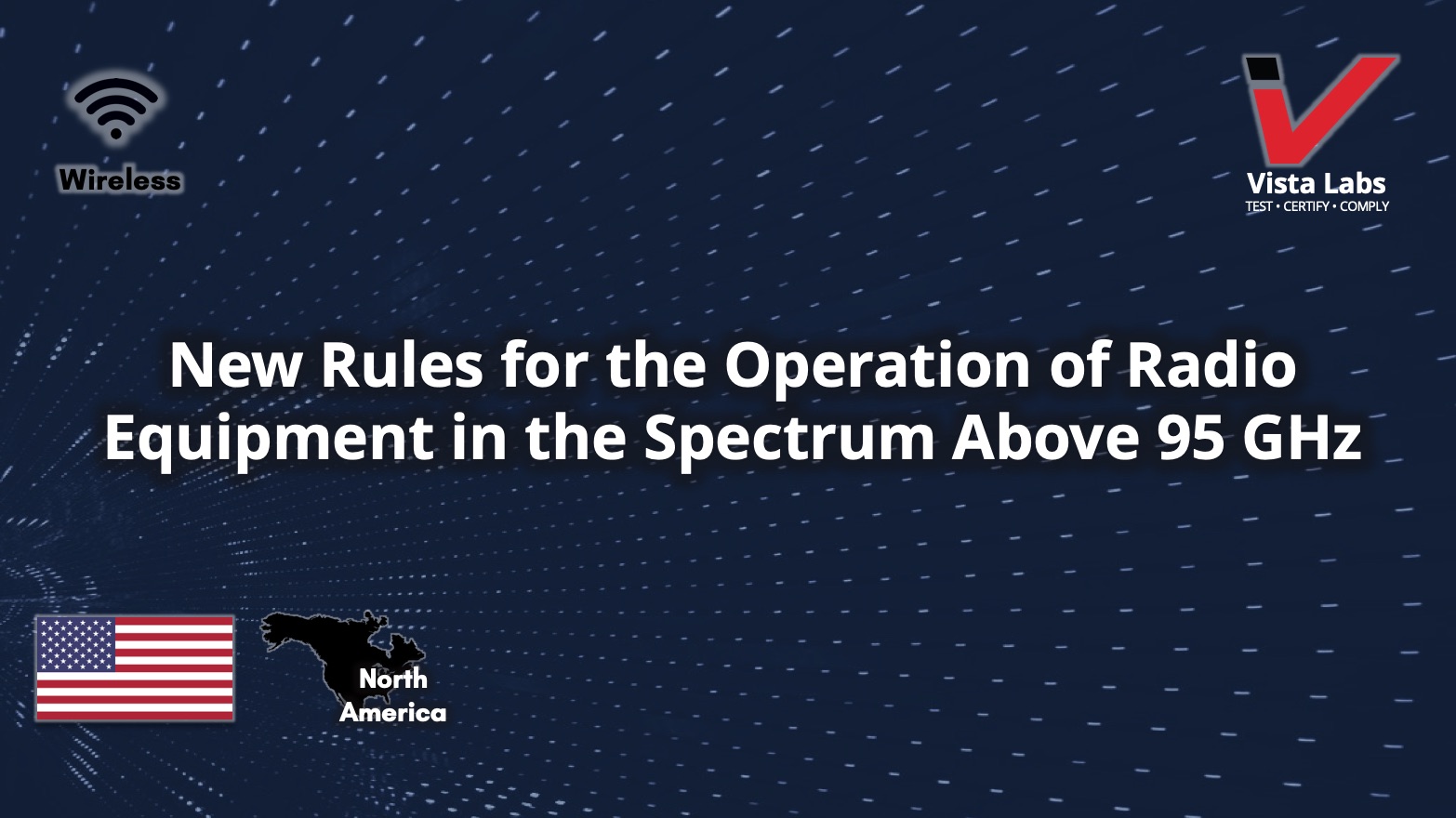The Federal Communications Commission (FCC) of the United States creates the new rule 47 CFR § 15.258 to expedite the deployment of services in the spectrum above 95 GHz.
The frequency bands designated for unlicensed use above 95 GHz and their current allocations are as follows:
| Band (GHz) | In Part 15.258 | Current Allocation |
|---|---|---|
| 114.25-116 | EARTH EXPLORATION-SATELLITE RADIO ASTRONOMY SPACE RESEARCH | |
| 116-122.25 | Yes | EARTH EXPLORATION-SATELLITE (passive) INTER-SATELLITE SPACE RESEARCH (passive) Industrial Scientific and Medical (122-123) |
| 122.25-123 | Yes | FIXED/MOBILE/INTER-SATELLITE Amateur Industrial Scientific and Medical |
| 123-130 | FIXED-SATELLITE MOBILE-SATELLITE RADIONAVIGATION RADIONAVIGATION-SATELLITE Radio astronomy | |
| 174.5-174.8 | FIXED/MOBILE/INTER-SATELLITE | |
| 174.8-182 | Yes | EARTH EXPLORATION-SATELLITE (passive) INTER-SATELLITE SPACE RESEARCH (passive) |
| 182-185 | EARTH EXPLORATION-SATELLITE (passive) RADIO ASTROMONY SPACE RESEARCH (passive) | |
| 185-190 | Yes | EARTH EXPLORATION-SATELLITE (passive) INTER-SATELLITE SPACE RESEARCH (passive) |
| 190-191.8 | EARTH EXPLORATION-SATELLITE (passive) SPACE RESEARCH (passive) | |
| 241-248 | Yes(244-246) | RADIO ASTRONOMY RADIOLOCATION Amateur/Amateur-satellite Industrial Scientific and Medical (244-246) |
| 248-250 | AMATEUR/AMATEUR-SATELLITE Radio astronomy |
The new rule part is to be added as follows:
§ 15.258 Operation in the bands 116-123 GHz, 174.8-182 GHz, 185-190 GHz and 244-246 GHz.
(a) Operation on board an aircraft or a satellite is prohibited.
(b) Emission levels within the 116-123 GHz, 174.8-182 GHz, 185-190 GHz and 244-246 GHz bands shall not exceed the following equivalent isotropically radiated power (EIRP) limits as measured during the transmit interval:
(1) The average power of any emission shall not exceed 40 dBm and the peak power of any emission shall not exceed 43 dBm; or
(2) For fixed point-to-point transmitters located outdoors, the average power of any emission shall not exceed 82 dBm and shall be reduced by 2 dB for every dB that the antenna gain is less than 51 dBi. The peak power of any emission shall not exceed 85 dBm and shall be reduced by 2 dB for every dB that the antenna gain is less than 51 dBi. The provisions in this paragraph for reducing transmit power based on antenna gain shall not require that the power levels be reduced below the limits specified in paragraph (b)(1) of this section.
(3) The peak power shall be measured with a detection bandwidth that encompasses the entire occupied bandwidth within the intended band of operation, e.g., 116-123 GHz, 174.8-182 GHz, 185-190 GHz or 244-246 GHz. The average emission levels shall be measured over the actual time period during which transmission occurs.
(4) Transmitters with an emission bandwidth of less than 100 MHz must limit their peak radiated power to the product of the maximum permissible radiated power (in milliwatts) times their emission bandwidth divided by 100 MHz. For the purposes of this paragraph, emission bandwidth is defined as the instantaneous frequency range occupied by a steady state radiated signal with modulation, outside which the radiated power spectral density never exceeds 6 dB below the maximum radiated power spectral density in the band, as measured with a 100 kHz resolution bandwidth spectrum analyzer. The center frequency must be stationary during the measurement interval, even if not stationary during normal operation (e.g., for frequency hopping devices).
(c) Limits on spurious emissions:
(1) The power density of any emissions outside the band of operation, e.g., 116-123 GHz, 174.8-182 GHz, 185-190 GHz or 244-246 GHz, shall consist solely of spurious emissions.
(2) Radiated emissions below 40 GHz shall not exceed the general limits in §15.209.
(3) Between 40 GHz and the highest frequency specified in § 15.33, the level of these emissions shall not exceed 90 pW/cm2 at a distance of 3 meters.
(4) The levels of the spurious emissions shall not exceed the level of the fundamental emission.
(d) Frequency stability. Fundamental emissions must be contained within the frequency bands specified in this section during all conditions of operation. Equipment is presumed to operate over the temperature range −20 to + 50 degrees Celsius with an input voltage variation of 85% to 115% of rated input voltage, unless justification is presented to demonstrate otherwise
(e) Regardless of the power density levels permitted under this section, devices operating under the provisions of this section are subject to the radiofrequency radiation exposure requirements specified in §§1.1307(b), 2.1091 and 2.1093 of this chapter, as appropriate. Applications for equipment authorization of devices operating under this section must contain a statement confirming compliance with these requirements for both fundamental emissions and unwanted emissions. Technical information showing the basis for this statement must be submitted to the Commission upon request.
(f) Any transmitter that has received the necessary FCC equipment authorization under the rules of this chapter may be mounted in a group installation for simultaneous operation with one or more other transmitter(s) that have received the necessary FCC equipment authorization, without any additional equipment authorization. However, no transmitter operating under the provisions of this section may be equipped with external phase-locking inputs that permit beam-forming arrays to be realized.
(g) Measurement procedures that have been found to be acceptable to the Commission in accordance with §2.947 of this chapter may be used to demonstrate compliance.
The full report and order can be read here.



